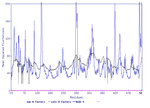Normal mode analysis HEXA
Contents
Webnma
General information
Results
We analysed the five models with the lowest energy values. Webnma calculates fourteen different models with following energy values:
| Mode Index | Deformation Energy |
| 7 | 1041.88 |
| 8 | 1318.21 |
| 9 | 1738.30 |
| 10 | 2841.31 |
| 11 | 3135.09 |
| 12 | 4100.18 |
| 13 | 3911.06 |
| 14 | 5337.50 |
| 15 | 5741.69 |
| 16 | 6513.85 |
| 17 | 6081.05 |
| 18 | 6882.96 |
| 19 | 7514.14 |
| 20 | 7943.67 |
We took the first five models (7, 8, 9, 10, 11), because they have the lowest energy of all models.
Here you can see the normalized squared atomic displacments of our models:
| model 7 | model 8 | model 9 | model 10 | model 11 |
Here you can see the motion of our analyses.
| model 7 | model 8 | model 9 | model 10 | model 11 |
Discussion
If we look at the squared atomic displacments of our models we can see that almost every model has a peak at the same place.
Here is an overwiew, where are the peaks of the models:
| position of the peak | value of the peak | position of the peak | value of the peak | position of the peak | value of the peak | position of the peak | value of the peak | position of the peak | value of the peak |
| model 7 | model 8 | model 9 | model 10 | model 11 | |||||
| 250 | 3.0 | 10 | 0.8 | 10 | 0.7 | 250 | 8 | 20 | 0.6 |
| 290 | 1.5 | 12 | 0.8 | 15 | 0.7 | 220 | 0.8 | ||
| 300 | 1.5 | 60 | 1.3 | 50 | 0.8 | 310 | 0.9 | ||
| 310 | 1.5 | 90 | 1.0 | 110 | 1.8 | 315 | 0.9 | ||
| 110 | 0.6 | 190 | 0.6 | 350-380 | ~1.2 | ||||
| 115 | 0.6 | 250 | 0.7 | 405 | 1.5 | ||||
| 250 | 2.0 | 310 | 1.2 | 500 | 0.9 | ||||
| 300 | 1.0 | ||||||||
El Nemo
General information
Results
Here you can see the CA distance fluctuations for the different modes:
This matrix displays the maximum distance fluctuations between all pairs of CA atoms and between the two extreme conformations that were computed for this mode (DQMIN/DQMAX). Distance increases are plotted in blue and decreases in red for the strongest 10% of the residue pair distance changes. Every pixel corresponds to a single residue. Grey lines are drawn every 10 residues, yellow lines every 100 residues (counting from the upper left corner).
| model 7 | model 8 | model 9 | model 10 | model 11 |
El Nemo provides three different animated gif to the user, which show the motions of the protein. Furthermore, we created another animated gif. Therefore, in this case we have four different anmiated gifs. We listed all gifs for one model in on line.
Model 7:
| picture from us | picture 1 from ElNemo | picture 2 from ElNemo | picture 3 from ElNemo |
Model 8:
| picture from us | picture 1 from ElNemo | picture 2 from ElNemo | picture 3 from ElNemo |
Model 9:
| picture from us | picture 1 from ElNemo | picture 2 from ElNemo | picture 3 from ElNemo |
Model 10:
| picture from us | picture 1 from ElNemo | picture 2 from ElNemo | picture 3 from ElNemo |
Model 11:
| picture from us | picture 1 from ElNemo | picture 2 from ElNemo | picture 3 from ElNemo |
Discussion
Anisotropic Network Model web server
General information
Results
Here you can see the B-factor distribution of the real occuring B-factors (black) and the calulated B-factors (blue).
| model 1 | model 2 | model 3 | model 4 | model 5 |
In the next table, the motion of the protein of the different models is shown:
| model 1 | model 2 | model 3 | model 4 | model 5 |
Discussion
oGNM – Gaussian network model
General information
Results
Discussion
NOMAD-Ref
General information
Results
| model 1 | model 2 | model 3 | model 4 | model 5 |
| model 1 | model 2 | model 3 | model 4 | model 5 |
All-atom NMA using Gromacs on the NOMAD-Ref server
General information
Results
600K
Here you can see the motion of 1BPT at temprature 600K.
| model 7 | model 8 | model 9 |
2000K
Here you can see the motion of 1BPT at temprature 2000K.
| model 7 | model 8 | model 9 |
Comparison to an Elastic Network Calculation
Next, we want to compare the result of All-atom NMA to an elastic network calculation (NOMAD-Ref).
| model 7 | model 8 | model 9 |































































